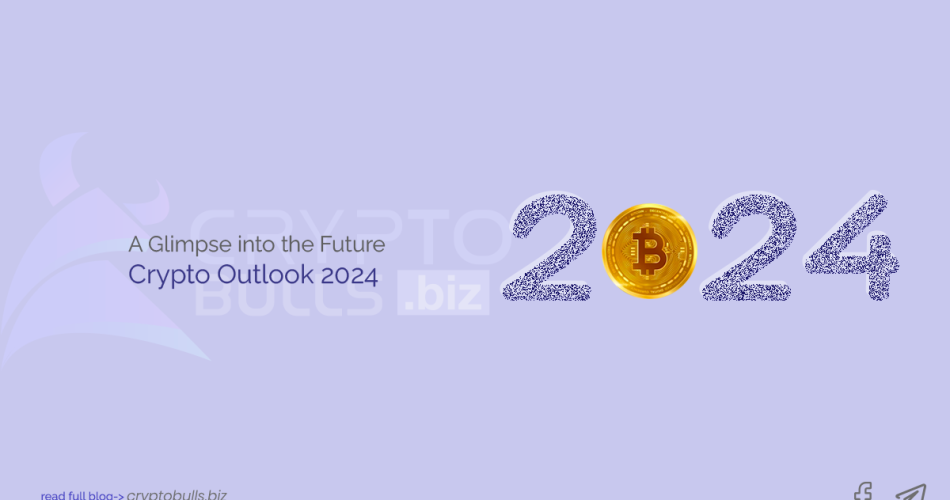A Glimpse into the Future: Crypto Outlook 2024
TradeDog, a renowned name in the crypto industry, has recently unveiled their much-anticipated Crypto Outlook 2024 Report. This comprehensive report provides a retrospective analysis of the past year’s significant events and trends, while also offering a forward-looking perspective on the potential developments and patterns that could shape the crypto landscape in the coming year.
This blog post aims to highlight the key insights from the report, which is enriched with valuable contributions from industry frontrunners such as Stepn, Enjin, Hacken, SuperScrypt, and others. It’s a must-read for anyone interested in the future of cryptocurrency, making it an essential resource for understanding the past, present, and future of this dynamic industry.
The State of Bitcoin and the Rise of Ordinals
Bitcoin has had a strong year-to-date performance, with a gain of 153% and a surge in market capitalization from around $318 billion to $860 billion as of mid-December. This growth has been driven by anticipation around the approval of the Bitcoin ETF and the planned Bitcoin Halving in April 2024. In the first half of 2023, there was a significant surge in network activity due to the emergence of the Ordinals Protocol. This led to an exponential increase in the number of transactions and the hash rate.
This year, the Ordinals Protocol, a Layer 1 protocol, has been a groundbreaking addition to the Bitcoin blockchain. It allows developers to create NFTs and fungible tokens on top of the Bitcoin blockchain. After the first inscription on December 14, 2022, the number of inscriptions surged from 1,000 to 100,000 in just two weeks. As of mid-December, a staggering 47.5 million inscriptions have been made, generating a total fee exceeding approximately 3556 BTC.

Source: Crypto Outlook Report 2024 by TradeDog
In 2023, Bitcoin’s daily transaction fees, driven by increased Ordinals-related activity, surpassed that of Ethereum. Bitcoin’s average fee surged to $38.4 in mid-December, reflecting heightened market interest in Ordinals-inscribed assets. However, this surge in fees doesn’t favor the mass adoption of Bitcoin as a blockchain, a problem that yet needs to be solved.
Future Outlook
The anticipation surrounding Bitcoin ETFs has significantly shaped market sentiment in 2023. With the potential approval of the first US Bitcoin ETF by the SEC in January 2024, and institutional firms like MicroStrategy holding substantial BTC holdings, Bitcoin is expected to continue its upward trend. This development is likely to spur more startups to work towards Crypto ETF investment, monitoring, and analysis tools. Additionally, the quadrennial Bitcoin halving event, which halves the reward earned by miners for adding a new block to the chain, is set to occur in April 2024. Historically, such events have been followed by a bull run. Although the maturing markets have likely factored in the halving effect, some activity may still be seen due to historical precedents.
The Intersection of AI and Web 3 in 2023
2023 marked a significant year for AI, with its integration into Web 3 sparking a wave of innovation across industries. Projects in this domain raised over $520 million, and token-based AI companies, led by The Graph token (GRT), reached a market capitalization of $15 billion. Decentralized AI emerged as a major trend, embraced by leaders like Nvidia, and has the potential to enhance data privacy and manage vast datasets. AI-driven smart contracts also emerged, enabling dynamic adaptation without manual code updates.

Source: Crypto Outlook Report 2024 by TradeDog
In the realm of Web3, AI was embraced to streamline daily life, mirroring trends seen in Web 2. For instance, Fetch.ai introduced a bot that uses AI to automate tasks like flight reservations. Web3 projects increasingly utilized AI to craft advanced analytics tools, such as Alchemy’s GPT-4 plugin designed for blockchain analysis, marking a transformative phase in the digital landscape.
Future Outlook
AI’s role in enhancing human creativity is set to grow, benefiting sectors from foundational work in the metaverse to building smart contracts and business process optimization. The shift toward decentralization will challenge the dominance of Big Tech giants, fostering trust and autonomy. The integration of large language models (LLMs) with zero-knowledge proofs (ZKPs) – ZKML could be a major trend in 2024, reshaping decentralized systems.
The Emergence of Real-World Asset Tokenization
In 2023, the tokenization of Real-World Assets (RWAs), which involves converting physical assets into digital tokens on a blockchain, emerged as a major trend. Commodities dominated the RWA market landscape with a Total Value Locked (TVL) of approximately $971 million, followed by government securities with a TVL of around $759 million. MakerRWA emerged as a leader in this category with a record TVL of $3.12 billion, closely followed by StUSDT. In terms of tokenizing government securities, Franklin Templeton led the pack with a market share of approximately 40.9%.
Platforms like MakerDAO and Ondo Finance have been gaining significant traction, with MakerDAO securing a substantial 70-80% of its revenue from stability fees tied to RWAs. As of writing, Ondo Finance’s TVL is approximately $198 million. MatrixDock, a digital assets platform offering institutional and accredited investors transparent access to tokenized RWAs, surged to a TVL of approximately $113 million during 2023.

Source: Crypto Outlook Report 2024 by TradeDog
Future Outlook
Looking ahead, progress made in 2023 has paved the way for substantial on-chain advancements, primarily driven by major financial players entering the space. The trend of tokenizing assets is likely to transcend traditional boundaries to include bonds, equities, and novel asset classes such as art, automobiles, commodities, and fine wines. Notably, Asia stands as a beacon in this landscape, with governments in regions like Hong Kong and Thailand actively reshaping regulations to embrace the potential of tokenizing real-world assets. The emerging trajectory indicates an impending multi-trillion dollar market for asset tokenization by 2030, highlighting a significant shift towards digitalized financial products and governments playing pioneering roles in shaping this burgeoning landscape.
The Rise of Liquid Staking Derivatives and Their Impact
In 2023, the ETH staking landscape saw the rise of liquidity staking derivatives (LSDs), enabling smaller validators to stake their ETH and generate profits. Despite anticipations of a substantial outflow surrounding the Shapella upgrade in April 2023, there was a significant net inflow of around 179.5k ETH within just four days. This signaled heightened activity around the network’s changes and potential investor movement. The Total Value Locked (TVL) across LSD protocols increased steadily in 2023 as a result of the Ethereum update and surged to an all-time high of $24 billion.
Lido emerged as a leader in the LSD segment with $17.5 billion locked in, commanding a 77% market share. RocketPool followed with a 9% market share amounting to $2.05 billion in TVL. The total amount of staked ETH witnessed a remarkable surge from around 15.86 million to a staggering 28.6 million. The number of validators also increased from around 495k to 895k in 2023, showcasing a monumental leap in Ethereum’s validation ecosystem.

Source: Crypto Outlook Report 2024 by TradeDog
Future Outlook
The growth of ETH staking is boosting LSDs, and it is likely to surpass traditional staking methods in market share due to higher returns. Experts predict staked ETH could quadruple, potentially representing 45% of the circulating supply, equating to hundreds of billions of dollars. Looking into 2024, the focus will be on developing secure yield aggregators and LSD-Fi reinvestment services, enhancing safety, efficiency, and value for stakeholders. Implementing rigorous security measures will be critical to mitigate risks and maintain market stability.
Maximal Extractable Value (MEV) and Its Impact in 2023
In 2023, “Maximal Extractable Value” (MEV), the potential profit miners or validators gain by manipulating transaction order or content in blockchain blocks, played a significant role in the crypto landscape. Validators or proposers earned a staggering 282.5K ETH, taking the total tally of ETH paid to 360.7K ETH post-merge. The distribution of ETH payments remained consistent over the year, with a major spike observed in May 2023.
MEV validators earned a whopping $75 million from arbitrage in revenue, which consisted of approximately $68 million in revenue from Uniswap, followed by Curve and Balancer with $26 million and $22 million in revenue respectively.

Source: Crypto Outlook Report 2024 by TradeDog
Future Outlook
Looking ahead to 2024, one of the major updates expected is the release of “The Simple Universal MEV Auction” (SUAVE). SUAVE aims to tackle prevalent issues within the current MEV framework, striving to establish a more decentralized, transparent, and fair MEV system within the blockchain ecosystem. Its concept revolves around a transparent auction mechanism, where users confidentially submit bids for their transactions, indicating the MEV they’re willing to offer for inclusion in a block. This setup prompts miners/validators to compete in forming blocks comprising the highest-paying transactions, thereby ensuring an equitable distribution of MEV among all involved participants.
Closing Thoughts
The Crypto Outlook 2024 Report by TradeDog provides a comprehensive overview of the significant events and trends that shaped the crypto landscape in 2023 and offers valuable insights into the potential developments for 2024. The intersection of AI and Web 3, the tokenization of Real-World Assets (RWAs), and the rise of Liquid Staking Derivatives (LSDs) were key trends that emerged in 2023. These trends, coupled with major financial players entering the space, have paved the way for substantial on-chain advancements.
Looking ahead, the focus will be on developing secure yield aggregators and LSD-Fi reinvestment services, enhancing safety, efficiency, and value for stakeholders. The trend of tokenizing assets is likely to transcend traditional boundaries to include bonds, equities, and novel asset classes such as art, automobiles, commodities, and fine wines. The emerging trajectory indicates an impending multi-trillion dollar market for asset tokenization by 2030, highlighting a significant shift towards digitalized financial products.


